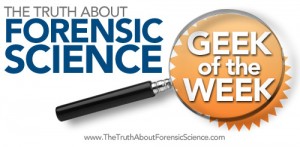The Forensic Science Geek of the Week
The week 27 “www.TheTruthAboutForensicScience.com Forensic Science Geek of the Week” honors goes to:
RICHARD MIDDLEBROOK

Forensic Science Geek of the Week: Richard Middlebrook
Richard O. Middlebrook
Position: Partner and Senior Attorney. Born Phillipsburg, New Jersey, June 6, 1968; admitted to bar, 1993, California.
Background: Mr. Middlebrook is considered the preeminent DUI attorney in the Southern San Joaquin Valley. He spends hundreds of hours a year attending, moderating and lecturing in seminars focusing on the representation of persons accused of driving under the influence of alcohol and drugs and the forensic science associated with those areas. He is a graduate of multiple summer sessions of the National College of DUI Defense held at Harvard University in Cambridge, Massachusetts and Winter Sessions held worldwide. He is trained as an Instructor in the administration of Standardized Field Sobriety Testing through the National Highway Traffic Safety Administration and is a regular attendee at Mastering Scientific Evidence Seminar.He has tried nearly 200 DUI cases throughout his career and acted as lead counsel in over five thousand administrative hearings, writ proceedings, motions, and appeals. His success rate in those proceedings is unmatched anywhere in the Southern San Joaquin Valley.
Education: California Lutheran University (B.A., Magna Cum Laude, 1990); University of California, Davis, Martin Luther King School of Law (J.D., 1993).
Professional Duties: Judge Pro Tem, Kern Count Superior Court. judicial Arbitrator, Kern County Superior Court.
Community Involvement: Kern County Sheriff’s Mounted Posse, Board of Directors (1998-2003); Bakersfield Active 20-30 Club, Board of Directors (2000-2003), 2nd Vice-President (Fall 2001), 1st Vice-President (Spring 2002), President (Fall 2002). National Director, Region 3, Active 20-30 International (2002-2003), National President-Elect, (2004-2005), National President (2005-2006), International President-Elect (2006-2007), and International President (2007-2008
Professional Affiliations: California Bar Association; Kern County Bar Association; American Bar Association; Member, National College of DUI Defense; Specialist Member, California DUI Lawyer’s Association; National Association of Criminal Defense Lawyers
RICHARD MIDDLEBROOK is Week 27’s www.TheTruthAboutForensicScience.com Forensic Science Geek of the Week!
Congratulations to our Week 27 winner! All hail the www.TheTruthAboutForensicScience.com Forensic Science Geek of the Week!!!
See the challenge question that our winner correctly answered.
Our winner answered the question correctly. Please visit the www.TheTruthAboutForensicScience.com FaceBook fan page.
Our Geek of the Week answered:
Scanning Kelvin Probe
Dr. Geraint Williams, H. Neil McMurray
[BLOGGER’S NOTE: Just to amplify….
We had a blog on this a while ago… Unused technology: Fingerprints off Brass Shell Casings due to corrosion.
Some more information from the researchers themselves:
The peaks represent voltages detected along the ridges of the fingerprint left behind on a metallic surface with the salt from sweat generating the tiny corrosion voltages that are detected by the Kelvin probe.
Since the late nineteenth century, fingerprint identification methods have been used by police agencies around the world to identify both suspected criminals as well as the victims of crime.
The basis of the traditional fingerprinting technique is simple. The skin on the palmar surface of the hands and feet forms ridges, so-called papillary ridges, in patterns that are unique to each individual and which do not change over time. Even identical twins do not have identical fingerprints. Fingerprints on surfaces may be described as patent or latent. Patent fingerprints are left when a substance (such as paint, oil or blood) is transferred from the finger to a surface and are easily photographed without further processing. Latent fingerprints, in contrast, occur when the natural secretions of the skin are deposited on a surface through fingertip contact, and are usually not readily visible. The best way to render latent fingerprints visible, so that they can be photographed, is complex and depends, for example, on the type of surface involved. It is generally necessary to use a ‘developer’, usually a powder or chemical reagent, to produce a high degree of visual contrast between the ridge patterns and the surface on which the fingerprint was left.
Developing agents depend on the presence of organic deposits for their effectiveness. However, fingerprints are typically formed by the secretions of the eccrine glands of the fingertips, which principally comprise water and inorganic salts, with only a small proportion of organic material such as urea and amino acids and detecting such fingerprints is far from easy. A further complication is the fact that the organic component of any deposited material is readily destroyed by heat, such as occurs when a gun is fired or a bomb is detonated, when the temperature may reach as high as 500°C.
In contrast, the non-volatile, inorganic component of eccrine secretion remains intact even when exposed to temperatures as high as 600°C.
Within the Corrosion Group , Professor Neil McMurray and Dr Geraint Williams have developed a technique that enables fingerprints to be visualised on metallic and electrically conductive surfaces without the need to develop the prints first. The technique involves the use of an instrument called a scanning Kelvin probe (SKP), which measures the voltage, or electrical potential, at pre-set intervals over the surface of an object on which a fingerprint may have been deposited. These measurements can then be mapped to produce an image of the fingerprint. A higher resolution image can be obtained by increasing the number of points sampled, but at the expense of the time taken for the process. A sampling frequency of 20 points per mm is high enough to visualise a fingerprint in sufficient detail for identification purposes and produces a voltage map in 2–3 hours. So far the technique has been shown to work effectively on a wide range of forensically important metal surfaces including iron, steel and aluminium. While initial experiments were performed on planar, i.e. flat, surfaces, the technique has been further developed to cope with severely non-planar surfaces, such as the warped cylindrical surface of fired cartridge cases. The very latest research from the department has found that physically removing a fingerprint from a metal surface, e.g. by rubbing with a tissue, does not necessarily result in the loss of all fingerprint information. The reason for this is that the differences in potential that are the basis of the visualisation are caused by the interaction of inorganic salts in the fingerprint deposit and the metal surface and begin to occur as soon as the finger comes into contact with the metal, resulting in the formation of metal–ion complexes that cannot easily be removed.
In any scene of crime investigation, a decision that has to be made at an early stage is whether to try to attempt to retrieve fingerprints through the use of developers or whether to swab surfaces in an attempt to salvage material for DNA fingerprinting. The two processes are mutually incompatible, as fingerprint developers destroy material that could potentially be used for DNA analysis, and swabbing is likely to make fingerprint identification impossible. The application of the this technique, which is completely non-contact and does not require the use of developers, has the potential to allow fingerprints to be retrieved while still leaving intact any material that could subsequently be subjected to DNA analysis.
We hope to have a forensically usable prototype in the near future and it is intended that eventually the instrument will be manufactured in sufficiently large numbers that it will be widely used by forensic teams on the frontline.]
The Hall of Fame for the www.TheTruthAboutForensicScience.com Forensic Science Geek of the Week:
Week 1: Chuck Ramsay, Esquire
Week 2: Rick McIndoe, PhD
Week 3: Christine Funk, Esquire
Week 4: Stephen Daniels
Week 5: Stephen Daniels
Week 6: Richard Middlebrook, Esquire
Week 7: Christine Funk, Esquire
Week 8: Ron Moore, B.S., J.D.
Week 9: Ron Moore, B.S., J.D.
Week 10: Kelly Case, Esquire and Michael Dye, Esquire
Week 11: Brian Manchester, Esquire
Week 12: Ron Moore, B.S., J.D.
Week 13: Ron Moore, B.S., J.D.
Week 14: Josh Lee, Esquire
Week 15: Joshua Dale, Esquire and Steven W. Hernandez, Esquire
Week 16: Christine Funk, Esquire
Week 17: Joshua Dale, Esquire
Week 18: Glen Neeley, Esquire
Week 19: Amanda Bynum, Esquire
Week 20: Josh Lee, Esquire
Week 21: Glen Neeley, Esquire
Week 22: Stephen Daniels
Week 23: Ron Moore, B.S., J.D.
WEEK 24: Bobby Spinks
WEEK 25: Jon Woolsey, Esquire
WEEK 26: UNCLAIMED, IT COULD BE YOU!!!!
Week 27: Richard Middlebrook, Esquire
Next week’s challenge will be posted on Sunday morning at 11 am EST. I AM LOOKING FOR SUGGESTIONS please email me at justin@TheMcShaneFirm.com



